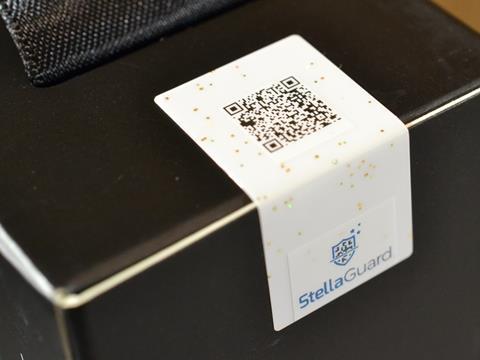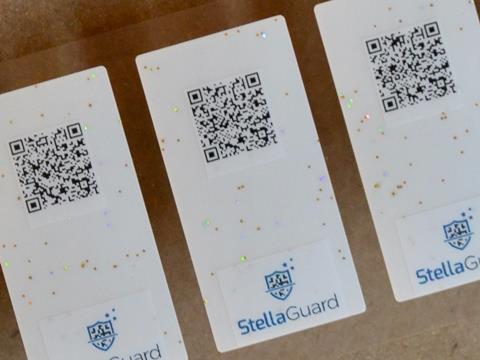
A changing landscape of consumption means that packaging security solutions are increasingly required to work harder – and be smarter – to protect consumers. The COVID-19 pandemic has significantly altered the way we browse and buy products, with an increase in e-commerce translating into more opportunities for counterfeiters. We speak with Dr Tobias Jochum from the Fraunhofer Institute for Applied Polymer Research IAP and Terrence O’Neill from Covectra about how engaging consumers in their own protection via packaging may be key to addressing these challenges.
According to research by the European Union Intellectual Property Office (EUIPO), more than 50% of counterfeit goods seized at EU borders are from e-commerce streams. “These channels tend to be leaner; product moves and inventories turn over more quickly, which can impact the opportunities your supply chain team have to audit and examine products in transit,” explains Terrence O’Neill, director of business development at Covectra, a company offering serialization-based solutions for product security.
Supply chains are expanding, becoming increasingly complex, and under extreme pressure. This means that companies must toe the line between meeting expediated consumer demand and ensuring consumer protection. The evidence suggests that, despite best efforts, counterfeit goods are making it onto the market. But with the rise of novel, globalised, and digital avenues of consumption, there are simultaneous opportunities for packaging innovation that makes the most of both familiar and emerging solutions to protect consumers.
While the risk to consumers may be growing, so too are opportunities for including consumers in the process of product authentication. Supply chains are liable to change, especially times of global uncertainty, but the endpoint remains the same: the consumer receives the product. According to O’Neill, “including the consumers in the authentication process is crucial. It is the last chance to prevent a consumer from potentially being harmed by an illicit product.” Consumers are the final gatekeepers, then, in the sequence of securitization that products – and packaging – undergo as they move through the supply chain.
Dr Tobias Jochum, researcher at the Fraunhofer Institute for Applied Polymer Research IAP, agrees: “For me, this is the most important step. Up to now, the end customer has rarely been involved in the authentication process. In my opinion, comprehensive product protection can only be guaranteed by a system that enables verification of product authenticity from the producer to supervisory authorities, such as customs, wholesalers, and retailers, all the way to the end customer.”

Hidden in plain sight: security behind simplicity
Therefore, companies are emphasising the role of consumers themselves – perhaps previously a missing link – when developing solutions for consumer protection. Nonetheless, this is a balancing act; there are some key considerations to account for when involving the consumer.
“In order to give the end user the possibility of product authentication, the methods must be simple and understandable, take only a few seconds of time and not interfere with their privacy,” says Jochum. “Complicated measuring devices and extra equipment for product authentication must be avoided at all costs.”
Consumers are increasingly familiar with the technologies being incorporated into packaging solutions. For example, the use of QR codes on packaging is already popular for adding value through extra content like tutorials for makeup application or nutritional information about a food product. These are recognisable and, on the surface, simple – all the consumer needs to do initially is scan them with a smart device.
“The solution needs to strike a balance by being simple for the consumer to use and understand the results, as well as having technology running in the background that effectively raise entry barriers to counterfeiters such as artificial intelligence,” O’Neill adds. For brands, what happens between a consumer scanning a package and receiving confirmation of its authenticity is significant. There needs to be a complex process of validation behind the scenes that maintains the simplicity for the consumer, but that hold up against the evolving methods of counterfeiters.
The consumer scanning a product may log their ownership of a product like a luxury wine in a centralised database, for example, which Jochum notes “dominate product authentication”. However, these are not invulnerable: “I also see the use of central databases as a challenge. Since IT security and data protection problems are pre-programmed when they are used. They are a popular target for attack, and how user data is handled is not always transparent. Manufacturers disclose their sales data, business relationships and supply chains to the database operator.” Involving consumers requires some reconfiguration for brands in terms of managing the complexities of supply chains and data exchanges without compromising consumer experience in both the short- and long-term. Consumers could lose faith in a brand due to a data breach caused by an anti-counterfeiting solution, even if the product is authentic.

Unique features and multiple futures
To bring consumers fully into the fold of packaging security, brands need to observe the trends already emerging in the sector. “Until a few years ago, there was a strict separation between physical and digital product authentication tools,” Jochum explains. “For some time now, I have been observing a trend that combines both worlds to guarantee improved protection against counterfeiting. The security features generated in this way are often characterized by a uniqueness comparable to the human fingerprint.”
According to O’Neill, Covectra’s StellaGuard label solution “combines smart technologies with universal brand protection” with a technology that, as Jochum describes, mirrors a human fingerprint. The solution involves a “unique serialized QR code” that works alongside “a three-dimensional image of holographic stars embedded in a random pattern inside the label. The holographic stars are distributed at varying depths and positions within the substrate and unique within each label,” apparently making them incredibly difficult to replicate. Consumers can scan the QR code using a smartphone to access information on the product’s authenticity via Covectra’s AuthentiTrack cloud-based solution, with applications across sectors ranging from apparel to pharmaceuticals.
Fraunhofer Institute for Applied Polymer Research IAP’s SmartID project, which is led by Jochum, also uses a “unique and authentic” label that can be read on smart devices. However, the aim of the SmartID project is to allow authentication without the need to connect to a database that could potentially undermine security. Currently in development, the research group is working on codes that are also cost-effective and offer enhanced protection where authentication is essential for harm reduction, such as when verifying whether a medical mask has the correct and certified features to be effective against COVID-19.
“I see a future trend in decentralized (offline) product authentication, i.e., verification of product authenticity without the need for a database system,” Jochum suggests. “For this, all the data required for authentication must be on the packaging. This can be realized, e.g., with information carriers with a lot of storage capacity, which can be printed on the packaging. The packaging then contains the database entry for this product.
“Such a process offers several advantages. First, it is more customer-friendly, since no Internet connection needs to be established. Second, offline verification avoids various IT security and data protection challenges. In addition, everyone in the entire value chain can then check the product for authenticity. Fourth, it eliminates the high costs associated with installing, commissioning, and maintaining databases. At the same time, this leads to a reduction in the CO2 footprint, also because technologies with high energy requirements such as blockchain are not needed.”
Going forward, for O’Neill, smart packaging is key for fostering the relationship between consumers and brands through the lens of security. “Today, as the Internet of Things (IoT) continues to create connections in so many different aspects of our lives, smart packaging continues to offer companies opportunities to align and integrate broader commercial objectives to increase revenue, reduce costs, along with the risk mitigation benefits of consumer protection.
“It enables organizations to tell their stories and differentiate themselves from their competitors, to build trust with the brand, and demonstrate how serious they take the duty of care to their customers through their risk prevention, authentication, and monitoring efforts,” O’Neill adds. “For consumers, it’s a convenient, transparent way to gain more insight into the product and company through the packaging solution that can simultaneously educate and help to keep them safe.”
While O’Neill is “reluctant to even offer a guess” as to future trends in packaging security, he refers back to “the consumer experience, how their expectations change and how technology evolves to meet those needs”. New and exciting innovations, O’Neill suggests, could come from other segments: “Virtual reality (VR) is just getting its foothold in entertainment, gaming, and social media. Is it beyond the realm of possibility that future anti-counterfeiting solutions will use VR to enhance the consumer experience and improve product protection? Perhaps consumers could virtually travel along the supply chain the product took to reach them. Could a VR response center provide better support to help consumers inspect product to address suspicions and uncover counterfeits? I am very hopeful and excited about these types of possibilities to protect consumers.”











No comments yet